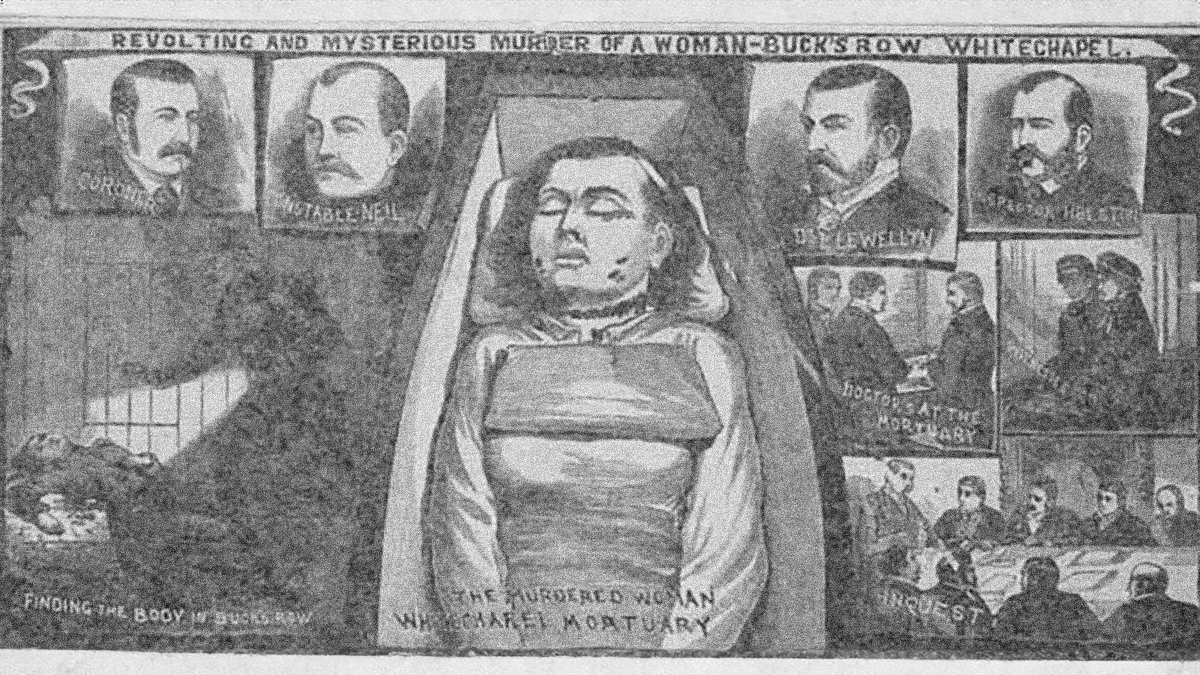
So my wife and I sat down and watched a couple of the most recent documentaries about Jack the Ripper, both on Tubi (where they were interrupted by commercials). The first was:
The Unsolved Killings of Jack the Ripper
Directed by Rebekah Llewelyn (2023)
This 48-minute summary of the canonical Ripper murders is hosted by Ripperologist Mick Priestly, author of One Autumn in Whitechapel. I keep seeing that book for sale when I search “Jack the Ripper” on Etsy, and I intend to read and review it.
This documentary is really a lecture by Priestly, interspersed with British actor Mark Kitto playing “The Policeman,” a character that seems based on London Metropolitan Police Chief Inspector Frederick Abberline, narrating. I wasn’t able to confirm if the “Policeman’s” dialogue was real or fictional, but I strongly suspect the latter.
Priestly, in his jaunty plaid cap and ridiculous gauge earrings, is quite good as a presenter, engaging and charismatic. Here he’s running through the basic facts of the five canonical murders. He starts out giving a fair amount of good background about Mary Ann Nichols; but as the lecture progresses, he gives less background on each successive victim, and lingers more on the lurid crime scene details. I wonder if Priestly actually gave more background information about the women, but this content ended up on the cutting room floor. Anyway, his facts are good and he presents them compellingly.
While he speaks, we see a lengthy series of short clips representing life in Whitechapel and the murders themselves, or at least the moments leading up to them. I want to talk about these clips for a moment. Some appear to have been stock footage, but most were created specifically for this show.
The Ripper is portrayed very stereotypically, as a well-dressed mustachioed white man in clean, expensive clothes with cape and top hat, and I think there was a shot of a medical bag. This is your basic Halloween Ripper, and I find it silly. Nobody noticed a conspicuously wealthy man haunting the streets of Whitechapel and Spitalfields that Fall.
The idea that the killer was a wealthy doctor or slumming aristocrat ties into a problem with many Ripper theories, the ones that center on famous or well-known Victorians. For the most part, wealthy historical figures are the ones we have the most information about, so the less creative or lazier Ripperologists target them. I assure you, the killer was not famous, or the friend of a famous person. Please, name one serial killer in the 136 years since who was famous or prominent before they were caught.
Priestly is not suggesting the Ripper was rich. He thinks it was likely Whitechapel engraver, troublemaker, and media hound Albert Bachert. According to Priestly, Bachert had a criminal record “for all the things you’d expect a serial killer to have today,” although he does not state what these crimes were.
Bachert repeatedly injected himself into the Ripper investigation, a common trait of serial killers. He claimed to know the Ripper, who he said was writing to him to “threaten him and warn him of the murders.” Bachert claimed the killer wrote graffiti on his house “but it was washed away before the police could photograph it “
Priestly adds that Bachert worked engraving banknotes, and that some Whitechapel women claimed to have been assaulted by a man who conned them with fake half-crowns, which as an engraver Bachert had the tools to make. He says Bachert was charged with forgery in 1889. It’s an interesting theory, which I intend to look into further.
But back to the re-creations. While weird planetarium-style music plays, the show’s fancy swell of a Ripper is shown confronting several of the victims with a large knife. Priestly seems sure every victim was a working prostitute the night they were murdered, while I think the evidence for this is weak—but the clips imply the women were willingly associating with the killer, presumably because they saw him as a customer.
In the re-creations, the victim is either surprised by the knife, or blasé about it, but in none of the clips do they scream or struggle or run. It’s weird—and to me drives home how unlikely it is the women were awake when their throats were slashed, since only the Chapman murder was overheard, maybe.
Priestly talks about poverty in Whitechapel, antisemitism connected to the case, and contemporary criticism of the police, which he seems to think was unwarranted. (There’s a lot of sympathy for the Met in the Ripperology community, which I find bizarre.) He wraps up by discussing why people are so interested in the Ripper murders a century later.
It’s partly the violence, it’s partly the area that it happened in, the slime and the cobblestones and the misery and the poverty. But it was also the first time something like that happened in a major city, with what would be referred to as a modern press following it. So it was the first case to receive anywhere near the amount of publicity it did, and then of course they never caught him; it’s always just stuck around in the public imagination.
This is one of the better TV documentaries I’ve seen on the Ripper, assuming all you want is a basic introduction to the topic. I like Priestly, and do intend to read his book. He gets a bit excited when discussing the gory details, but that excitement might be an unfortunate requirement of a show like this.
The Ripper docs I’ve already seen have been pretty terrible, so liking this one is not a strong recommendation. I’ll keep watching, to see if I come across one I can wholeheartedly recommend.


Leave a Reply